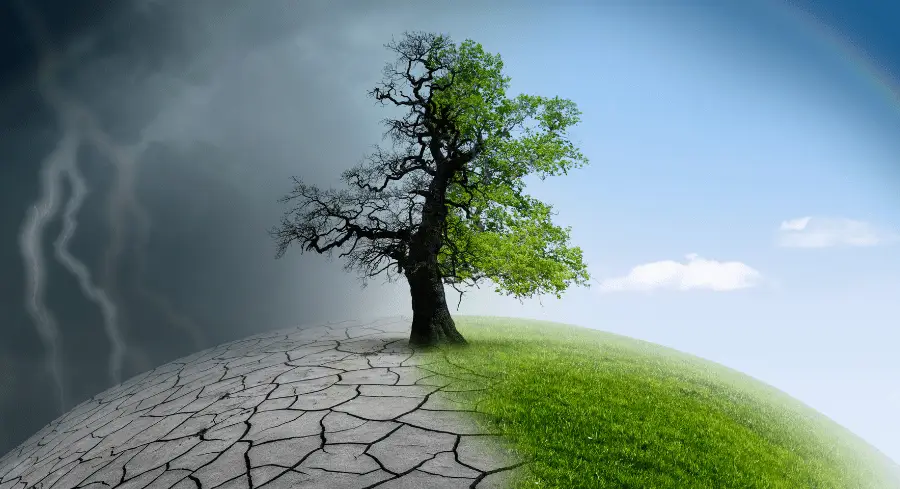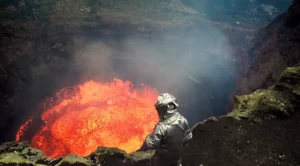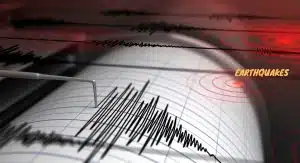Climate Change Awareness: Are You Doing Enough?
By TOI Desk Report
September 15, 2023
Update on : September 15, 2023

We all know about climate change; we have heard about global warming and its potential effects from various documentaries on TV or online. However, most of us still don’t seem to understand the gravity of the situation. It all seems so far away that most of us don’t feel a serious sense of crisis.
CyberGhost highlights that the global mean temperature measured last year was 1.16˚C higher than pre-industrial levels from 1850 to 1900, according to the UK’s Met Office. It’s no secret that anthropogenic influences are contributing to global warming, with some of the most important industries like animal agriculture, which includes livestock farming and deforestation, as well as burning fossil fuels and the textile industry. If we continue to support these practices, we will be faced with increased temperatures, which would impact at least 3 billion people.
Climate change and global warming are not the problems of the distant future; you and your children will likely live to see that horrible world.
The harmful effects of climate change:
Every aspect of our lives is interconnected; when one part is messed up, it starts a chain reaction that affects everything else. The same applies to global warming; it will affect more than just the climate and have far-reaching social, political, and economic impacts. Here are some of the most severe consequences of climate change.
I. Impacts on the Ecosystem
The Earth is home to more than just humans; more than 380,000 plant species and millions of animal and insect species live on it as well. All these species are adapted to living in their specific ecosystems. These ecosystems are delicate; even small changes can mess up everything.
1. Ocean Ecosystems
Global warming can cause glaciers and polar ice to melt, decreasing the sea water’s salinity. This could have adverse effects on ocean-dwelling creatures that are adapted to a specific salinity. Global warming will also increase the average temperature of the seawater, which would have a negative impact on the cold-water fish. It might force them to change their habitat, or they might fail to adapt to sudden changes and go extinct.
Many ocean creatures use temperature to determine their gender during incubation; a few degrees more or less could lead to an egg being male or female. Usually, each species lays eggs at specific places at specific times; the temperature there is suitable, so the ratio between the two genders remains roughly equal. However, global warming can mess up this ratio; a few degrees more can mean all eggs hatching into females or males, neither of which is good for a population.
2. Land Ecosystem
Climate change and global warming can just as severely impact land ecosystems. Rising temperatures and a lack of rain can cause dry regions to become dryer. This will put extreme pressure on the plants and animals in the area, forcing them to either move or adapt. This is already happening; for example, polar bears live on arctic ice and eat seals, fish, and other creatures in the area. Now, they are being forced to move away towards land because arctic ice is melting. This has led to a decrease in polar bear population. This is just one example; many other animals and plants have difficulty surviving due to climate change. If the climate change trend continues, thousands of plants and animal species will become extinct by the end of the century. This mass extinction will severely impact the whole planet, and the world will never be the same again.
II. Economic impact
The economic impact of climate change will be huge, and it will affect every country in the world; here are some reasons why:
1. Rise in Food Prices:
As mentioned before, global warming will lead to a decrease in rainfall, affecting food production. The places with warm climates suitable for farming will become barren and aired. This will lead to inflation, where the food prices will skyrocket and affect every part of the global economy.
2. Natural Disasters:
Climate change will also drastically change the weather patterns and increase the risks of natural disasters. Governments worldwide will have to spend a lot of money dealing with the aftermath of these disasters, which will place an extra burden on their economy.
3. Extreme Heat:
The rise in global temperatures will make the currently hot areas hotter; this extreme heat will make working outside during the day impossible. This will significantly decrease the productivity of these regions and will further worsen the global economic situation.
4. Increased power usage:
The rise in global temperatures will force more people to use air conditioners. Although ACs are already quite common in developed countries, the extreme heat will force even the citizens of poor and developing countries to use them in a few decades. This increased power consumption will further exacerbate the global economic problem.
5. Migrations
It will push the people living in urban areas to move towards the cities. For example, the farmers who make a living through farming will have to move when their land can no longer produce enough food to support their families. People living in the coastal regions will have to move because of the rising sea levels. These large-scale displacements will put more burden on the already fragile economies of the affected countries.
These are just some of the most common ways global warming and climate change could affect the global economy. If we do not take serious actions to stop this problem, the coming days will be far worse than they are now.
III. Health impact
Climate change and global warming will have a profound impact on our health as well. It can support a whole host of different diseases, making them more active and widespread around the world; for example:
1. Vector-borne diseases:
Vector-borne diseases are diseases that are spread through insects or other similar hosts. The most common examples of these diseases are malaria, dengue fever, Zika virus, and Lyme disease. The temperature rise can produce a suitable environment for the hosts of these diseases. For example, mosquitos, the hosts of malaria and dengue fever, love hot, humid places, and global warming will provide just that. This will make them reproduce rapidly and spread the diseases they carry with them to a farther distance.
2. Water contamination:
Climate change can lead to flooding, leading to diseases caused by contaminated water. The water from floods can contaminate the drinking water, leading to various diseases such as cholera, typhoid fever, dysentery, hepatitis A, typhoid, and polio.
3. Respiratory diseases:
We are already polluting the air; if this trend continues, then this will inevitably increase the chances of respiratory diseases. Global warming will lead to more forest fires and heat waves, increasing the chances of diseases like bronchitis and asthma.
4. Food-related diseases:
Climate change will put increased pressure on crops and plants; the extreme heat and long-term droughts could weaken their resistance to pests and pathogens. The farmers might be forced to use pesticides to kill off pests and use more fertilizer to increase yields. This will affect the quality of food and will lead to various food-related diseases such as salmonella, E. coli, Hepatitis A, Botulism, and listeria. These diseases are already on the rise recently, and the trend of climate change and global warming will only make things much worse than they are now.
IV. Political impact
If the current global warming trend continues, then in the coming years, we will not only have to deal with starvation, disease, and inflation, but we will also have to deal with the unrest caused by these.
As mentioned before, global warming will make some parts of the world too barren or too hot to live in, so people living in those areas will migrate to other areas. This will inevitably put the areas where they will go under greater pressure, which can cause conflicts between refugees and the natives. Due to the scarcity of arable land and freshwater, countries around the world will fiercely compete for them, causing wars and global unrest.
Importance of individual actions
Now that we know what harmful effects global warming will cause let’s talk about how to stop the worst from happening. Global warming, as its name suggests, is a big problem that makes people feel humble and small. This makes most people believe that only governments and mega organizations can do something about this issue.
However, that is not entirely true; while governments and large organizations will be the main force against this issue, this doesn’t mean that individual actions are insignificant. According to Energy Start, the USA could save 250,000 cars worth of greenhouse emissions and 18 million gallons of water in one year if the country’s citizens buy eco-friendly devices in that year. This proves that small actions, when done by everyone, can make a huge contribution to the global warming problem. Here are some small eco-friendly things you can do to make a difference:
I. Daily Habits Matter:
There are plenty of good habits that, if everyone follows them daily, can greatly reduce the overall carbon emissions; here are some of them.
1. Eat less meat:
Producing meat requires a lot of things that are extremely harmful to the environment. The farm animals need a lot of food, so we cut down forests to make more room for pastures; this reduces the forests that could have helped take carbon dioxide out of the air. The digestion process of the livestock also produces methane, a more potent greenhouse gas than carbon dioxide. The carbon footprint of meat is several times more than plant-based foods, so eating less meat overall can make a big contribution.
2. Save power:
Nowadays, most of our electricity is produced using fossil fuels, so using less whenever possible is a good habit. Many people have a bad habit of leaving their lights on even when they don’t need them or when they are outside their house. You can contribute by switching off the lights and appliances whenever you are outside. And don’t leave your devices on standby mode because this still consumes some electricity; instead, switch them off. Saving electricity is not hard, and it is good for the environment and your pocket.
3. Use eco-friendly methods of transportation:
Nowadays, cars and motorcycles are popular transportation sources, and most of them burn fossil fuels, which is not good for the environment. You can contribute by using transportation methods that are less harmful to the environment. If you are not going far, use a bicycle or simply walk there on foot. If you are going someplace far, use public transportation or carpooling, as they produce less emissions per person.
4. Do not waste food:
Only buy as much food as you are going to eat, and don’t throw away any food. This food ends up in landfills, decomposing and producing methane, contributing to global warming. If you have extra food, share it with others, such as your neighbors or people in need. If that is not possible, composting that food is the best option, as this process less emissions.
5. Use things longer
Try to use your clothes and other accessories for longer; do not throw them away before they are unusable. Most people throw away their perfectly fine clothes just because they think they are out of trend or they want to buy new clothes. Everything we buy produces emissions in the manufacturing process; by using a product longer instead of buying a new one, you are lowering the emissions.
II. Supporting Sustainable Brands:
Another important thing you can do to help with the climate crisis is to support eco-friendly brands. Choose products from eco-friendly companies when buying day-to-day necessities, home appliances, or anything you need. If you have savings that you want to invest somewhere, choose companies that follow and enforce eco-friendly policies. This will not only lower your carbon footprint but will also force other companies to follow eco-friendly policies.
Challenges in Adopting Eco-Friendly Habits
Changing your habits can sometimes be surprisingly difficult, even when it is for the greater good. Here are some challenges that people might face when adopting eco-friendly habits.
1. Socio-Economic Barriers:
Some people might not have the resources available to adopt these good habits. For example, someone in developed countries may not be able to afford an electric car because of their higher costs compared to normal cars. People in developing or underdeveloped countries may be unable to buy an electric car because of a lack of charging stations or high electricity costs.
2. Deeply ingrained habits:
Another reason some people cannot adopt eco-friendly habits is due to cultural and behavioral barriers. For example, Americans love to eat meat; according to some estimates, an average American consumes around 264 pounds per year. If you ask them to lower their meat consumption to help in the climate crisis, some people might not be able to do so. The meat-eating habit is deeply entrenched within them, which takes a lot of effort and willpower to change.
3. Misinformation:
Misinformation is another reason some people don’t adopt eco-friendly habits. This is especially true in the older generation and people in developed and developing countries. The most common misconceptions about the climate crisis are:
- The climate crisis is not real.
- It is not very harmful.
- There is no need to take action to stop it.
This misinformation is usually spread by fossil fuel interest groups, such as oil-producing countries or companies dealing with them.
Potential change through younger generation involvement
According to some studies, the younger generation is giving a more positive response to climate awareness response than older generations. They have grown up hearing about climate change and global warming and have access to various related resources online, so they have a better understanding of the gravity of the situation. Here are some ways younger generations are helping with the climate change.
1. Eco-Friendly habits:
Studies have shown that younger individuals are likelier to change their habits to become more eco-friendly. This can be seen in the rise of veganism among youngsters in the USA and other developed countries.
2. Awareness and Education:
Younger individuals are taking a more active role in climate awareness campaigns. Many young environmental activists, such as Greta Thunberg, are raising their voices for climate awareness and pushing the issue to the forefront.
The younger generation is well versed in electronic media, so they use social media, blog posts, and videos to spread awareness among their peers and the older generations. After recognizing the importance of their views, politicians and governments worldwide are implementing various eco-friendly policies.
3. Innovation and Entrepreneurship:
After recognizing the importance of climate change and sustainability, young innovators and entrepreneurs are creating eco-friendly products. They are using the latest technology to develop new products to solve various environmental challenges.
4. Political Engagement:
Many people from the younger generation are running for political office on various levels. These young politicians are actively participating in the policy-making process and are supporting eco-friendly policies.
Conclusion
Climate change is a global crisis that can threaten the entire world. If we do not take it seriously, it can make the earth uninhabitable in a few centuries. This is a problem that humans have highly contributed to, so it is up to us to solve it. It is only through our collective efforts that we can effectively address this problem.
















